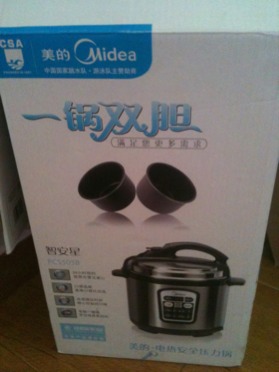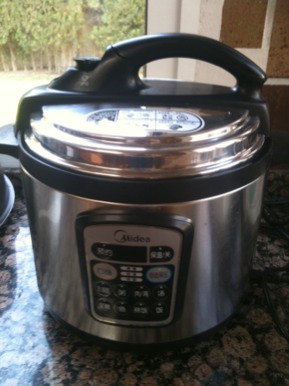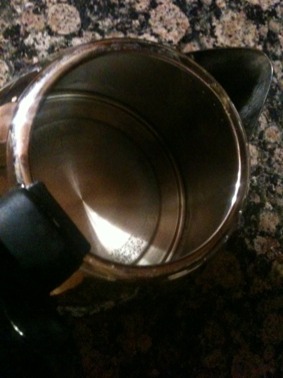
andrestorrubia
-
Posts
29 -
Joined
-
Last visited
Content Type
Profiles
Forums
Store
Help Articles
Posts posted by andrestorrubia
-
-
Hello, here's how I do it (I have never tasted "real" gravlax so my reference is my own... :-) ):
Big piece of salmon, bones out and also skin out so both sides are flesh. Piece should be of equal thickness as much as possible. Dry with a paper towel (the purpose of drying it is just so residual water doesn't get sucked up by the vacuum sealer).
5% of the salmon weight is a mixture of 40% salt (coarse, smoked salt adds a nice touch but not required) and 60% brown sugar.
So for example for 1 Kg salmon it's 50 gr of salt/sugar mixture: 20 gr salt, 30 gr brown sugar evenly distributed on both sides.
Vacuum seal it and place in the fridge for 2 days. Liquid will start leaking from the salmon, but there is no need to open the bag and take it out (in my experience it does not reabsorb it and if it does there is no ill effect). I flip sides after 24 hours, but that's it. A few times I've forgotten and I have not felt the difference.
After 2 days (or 3... 4, no huge difference) take it out of the bag, discard (or save) the juice, rinse salmon with water to remove any salt that may be left, pat dry with paper towel and then vacuum seal it again if you plan to keep it for a few weeks.
Doing it this way is great and no issues whatsoever. I've done countless small variations: adding extra dill, pepper, beetroot, juniper, katsuobushi flakes (big winner)... all of them work, it's just a matter of preferences imho.
My initial question was triggered by an experiment I which I removed the sugar from the mixture but kept the salt amount... eg. for 1 Kg salmon 20 gr. salt but no sugar. I expected it to be similar to my regular version but turned out to be much saltier. Juices came out too, although I didn't measure if it was more or less juice than with the regular one.
How does my regular version compare to CatPoet's?
Mine uses 20 grams of salt, CatPoet's 70 grams
Mine uses 30 grams of sugar, CatPoet's 56 grams
Mine doesn't use dill or pepper
Mine uses vacuum sealing, CatPoet's uses pressure by weight
My regular one tastes great, and I am cure CatPoet's does too... I eat mine for breakfast almost daily and I don't cut it in thin slices but more like bites of fish. I think temperature is key so I place it about 40 seconds in the microwave at 180W so it reaches ~20C (my fridge is 2C and it's way too cold, taste is resented heavily when eating it that cold).
The reason I asked in the first place is because I am not use I am eating a lot of salt and the sugar is just masking it (my the salt is there nonetheless). I think I will try with raw rice as bodin noir suggested. Also I will try with MSG instead of salt (MSG has 1/3rd sodium compared to salt by weight)
-
may i ask what vacuum sealer you are using ?
just curious ....
Hello - it's this one:
http://www.magicvac.magicvac.it/en/magicvac/1/master/14/maxima
-
I routinely have marinated salmon for breakfast, which I prepare adding a pinch or salt and brown sugar to salmon and vacuum sealing it. In my experience vacuum sealing it with the salt and sugar allows for dramatically reducing the amount of sugar/salt need and the time to marinate it can be extended to days instead of hours with little risk of the fish becoming too salty.
Here's a pic:
So far so food. The other day I decided to do it again except this time I would not add any sugar, just salt. The result was the same in terms on consistency:

BUT the fish was way to salty, almost inedible to my taste; and I am not sure why:
* Is the amount of salt present in the fish the same in both versions but the sugar just masking some of the salty taste?
* Is sugar preventing some of the salt getting in the fish?
For health reasons I would like to limit the amount of salt I take. Are there any other ways (excluding smoking) to remove part of the water from an oily fish like salmon?
Suggestions greatly welcome!
-
Yes, it's 220AC (I'm in Europe) - I guess I was lucky when I tried the rice porridge with wild rice as it cooked the rice just right. I tried it again with regular rice and I got, well... rice porridge. :-)
-
Thanks a lot!
-
-
Hi - I got this as a present:


But as you can see everything is in Chinese.
I've already tried one setting with wild rice and the results have been very nice, but as you can imagine I am flying blind.
Could anybody with Mandarin knowledge help me out, I am mostly interested in this:

And maybe (?) this:

Thanks in advance!
-
I am getting MC for Christmas, and I'd like to try some of the recipes in the book.
I'd like to document my experiences in a blog but it would be of little use for non MC owners if the recipes are not (partially?) described along with results, thoughts, etc. In one extreme, I am sure simply transcribing all the recipes into a blog would not be OK, but I wonder if one can use a recipe as a post topic, describing the recipe and adding some value without risking being sued or DCMA'd.
Any guidance?
-
I'd too would love an iPhone app or webpage with searchable ingredients.
There's a similar concept (albeit pairings are found via analyzing volatile molecules of ingredients rather than talking to chefs) at www.foodpairing.com, although the susbscription price 129 EUR + VAT/yr may be a bit steep.
-
You can do something similar with normal garlic with a Thermomix, very handy when having many heads of garlic to work on!
http://www.velocidadcuchara.com/2011/05/como-pelar-ajos-con-thermomix-paso-a-paso/id=598
-
Actually I used a small WMF pressure cooker this time (mines resembles the 3 quart one here) so the total water vapor to achieve full pressure is less than if using the full sized pressure cooker; and it requires less energy too.
-
I pulled the trigger and made the soup with just enough olive oil to coat the bottom of the cooker; added a tiny bit of water and left it for 45 mins... great results. I wonder if this also doable with tomato; although tomato being much more acidic than carrots (?) would mean adding a bit more soda powder and possibly a reducing sugar (maybe just a pureed sweet apple). Will try.
-
Hi Scott - If you ever visit Spain... you have a customer here! :-)
-
Hello - I made the carrot soup, and it was delicious. I substituted butter for margarine and I wonder if it would be safe to use olive oil. I understand one should not use oil while pressure cooking (and in fact I was a bit worried when using margarine) for safety reasons.
Would it be safe to substitute butter for olive oil in the carrot soup?
-
Re: measure & salting. I don't recall the book's name where I read it but I think the amount of salt to be added to any (non-salted) food was about 0.5% of the total weight.
-
Soak fish in a 5% brine for ~10 mins before cooking. I've learnt it from here: http://blog.khymos.org/2011/04/01/tfp-2011-sous-vide-master-class-part-2/ (head to the FISH section)
-
Jenni - It's a matter of preference, and I'd rather have sauces w/o seeds if the effort is reasonable; for homemade ketchup I think deseeding is a must. I love the tomato water; in fact it's one of the things I look forward when going for the whole tomato pureeing operation!
I tried once with the French mill but either I don't know how to use or my mill is just junk; very messy indeed.
Re: different-size meshes; is there any such thing as a French press with adjustable meshes?
-
I am trying to make tomato puree and tomato sauce using naturally ripened tomatos and I've learnt that the gel that surrounds tomato seeds is a big contributor to the umami tomato flavor (http://www.rsc.org/chemistryworld/News/2006/May/05050601.asp).
After peeling the tomatos, I puree them and get tomato water, tomato flesh and seeds (seeds are not broken by pureeing but their gel has blended in the puree).
I extract the water by pouring the puree into a cheesecloth bag and let it rest overnight; the water drops slowly and by the next day all left in the cheesecloth bag is a thick tomato puree of tomato flesh and seeds and very little water.
How do you filter out the seeds from the tomato puree?
-
One supposedly expert in EVOO (he was a wholesale distributor of EVOO) told that OO has 3 enemies: cold, light and oxygen. In Spain nobody I know of freezes OO, and it is always stored in dark places (a stainless steel or ceramic non-translucent jar better) and if you are worried about oxidation (I am), redistribute your OO to smaller jars so the ratio of OO to oxygen is as high as you can make it (this is a problem especially with big 5l carafes).
-
I'm exploring the concept of a modernist "tortilla de patata" aka "Spanish omelette" and I plan to SV the eggs (well mixed) to attain a honey-like viscosity.
Has anybody played with SV egg custards?
-
Oh - simple sandwich "bocadillo" with canned tuna, green olives stuffed with anchovies and a habanero pepper if you like it spicy.
-
Has anybody tried extracting juice with a pressure cooker?
I ran an experiment last week to extract pomegranate juice from the same quantity (in weigth) of pomegranates using a a) food processor and strainer; and b) a pressure cooker and strainer. I used South African pomegranates for the experiment (which were extremely red and a bit too acidic) The yield was almost the same in each case but the pressure cooker one (once refrigerated) tasted remarkably good (better imho if you asked me than the regular one).
Now that we're starting local season (in Spain) I will repeat the experiment with the local produce (which is significantly sweeter than the South African ones) adding extraction with a regular juice maker to the test.
-
Thanks - I feel a bit more relieved now. The kettle is a cheapo Chinese one, but works very nice, boils water super-fast and has a safety turn-off feature. If this is just scale, I think I may want to get rid of all the water every time I use (as opposed to letting leftover water sit there).
-
Hello,
I have an electric kettle what I use daily for tea brewing.
I've noticed that the bottom of the kettle (ie the heating base) has developed grey bits of stuff:

As you can see the base has an internal circle; the grey rust has developed at the exterior of that inner circle.
I can clean it with a metallic brush, but I am worried nonetheless.
I use tap water (water is hard where I live).
Any ideas?
Thanks!



Marinated salmon without the salt? Or... suggestions to remove water from fish w/o salting or smoking it?
in Cooking
Posted
I forgot, same exact recipe (except skin is not removed...) works beautifully for bonito:
...in this one the mixture is the same sal/brown sugar... just add some Katsuobushi flakes (better if you peel it yourself in you have a "block").